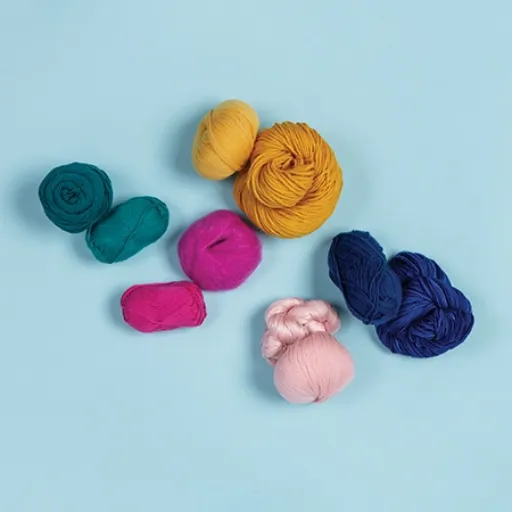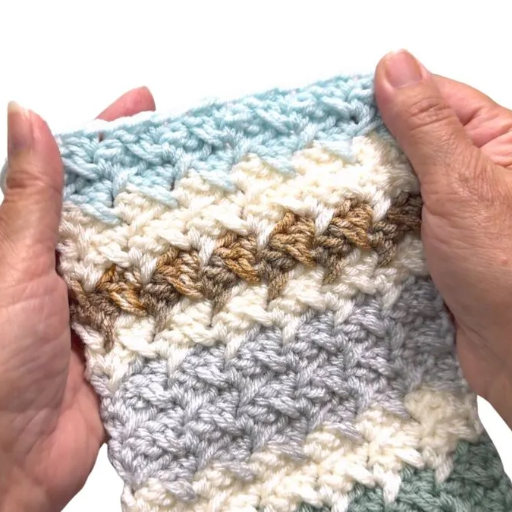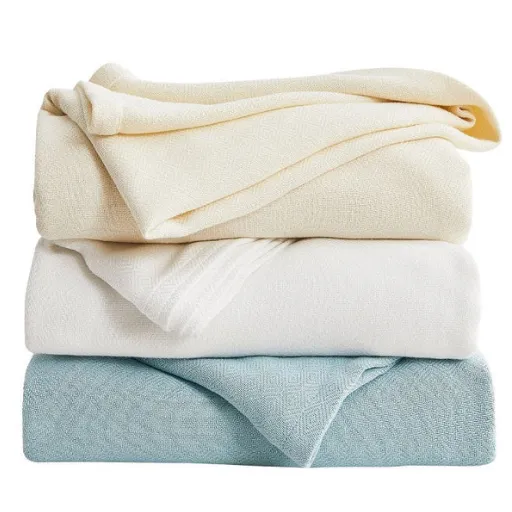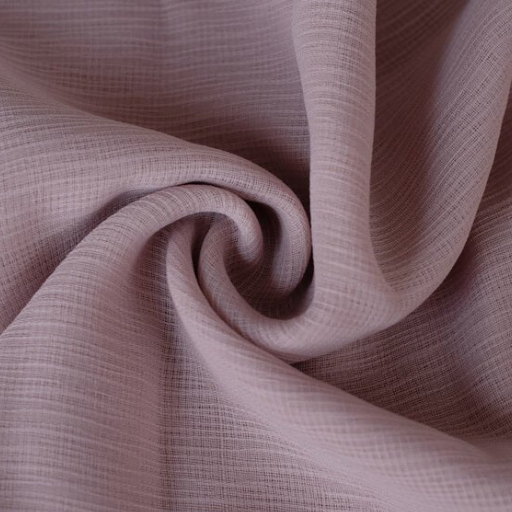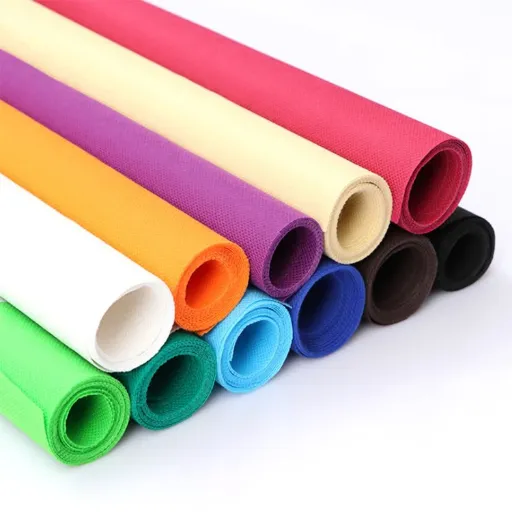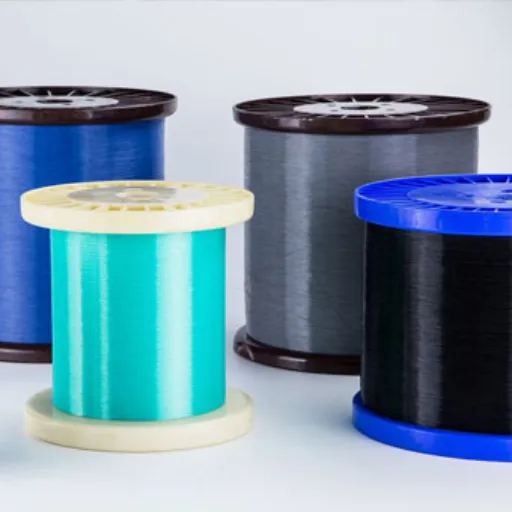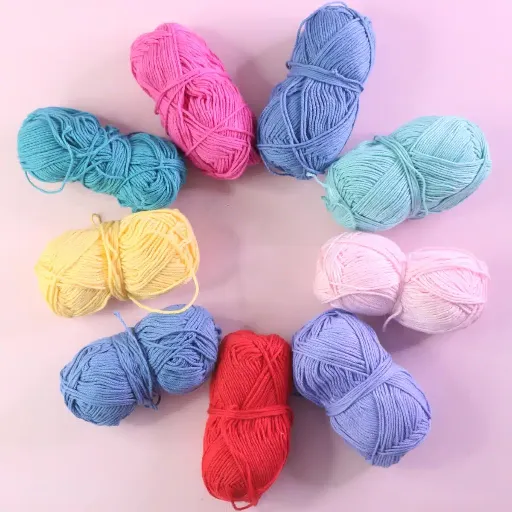When it comes to crochet projects, the kind of yarn that goes in can really dictate the output of your work. Amongst the myriad of fibers at your disposal, acrylic and cotton yarns have the highest possibility of being considered classic options, each with distinct features that can double for different requirements. But how does one choose the perfect yarn for the next project? This article shall provide you with the key differences between acrylic and cotton yarn, comparing things such as texture, durability, cost, and application. You have the capability to choose between making warm blankets, soft daylight garments, or intricate trinkets. This article will guide you through to make an informed choice to guarantee that your project comes out exactly as you envisioned. Let’s weave through all these aspects and choose the yarn that best suits your creative vision.
Introduction to Acrylic and Cotton Yarn
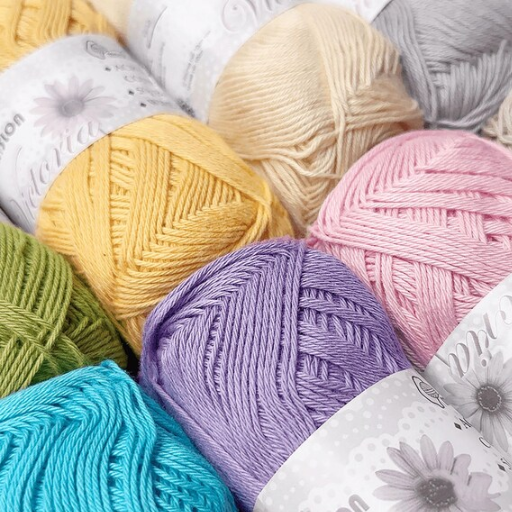
Acrylic and cotton yarns offer very distinct features, and each finds its place in projects depending on the preferences of the maker. Being a synthetic fiber, acrylic is cheap, lightweight, and wear-resistant, so it gets used for making colorful blankets, scarves, etc. On the other hand, cotton is a natural fiber that offers softness, breathability, and strength to withstand any form of situation under which the cotton yarned fabric will be rubbed. This yarn is thus suitable for warm-weather gear, baby stuff, and any projects that require a smooth finish from start to finish. Depending on specific textures, durability, or how suitable it would be for climate conditions, one can opt for either.
Overview of Acrylic Yarn
Being a cheap synthetic fiber, acrylic yarn gained popularity amongst the needle workers, beginner or professional. It is synthesized after polymerization of acrylonitrile, a chemical that renders it durable yet lightweight. Acrylic yarn, first and foremost, does not fade and welcomes mold and mildew prevention-well-suited for projects laid out under a spotlight or in humid atmospheres. The splendid lineup of colors on offer is one of the plus points: these yarns retain their color for a long time even after repeated washing.
The fiber is machine-washable and fast-drying, affording practicality for daily use. Its bounce and loft appeal to those in search of making cuddly warm items like sweaters, hats, and blankets. Unfortunately, an acrylic yarn favors better-than-wool or cotton fibers in breathability and wicking ability; a synthetic prevents some of these qualities. Recent advances in manufacturing have brought in disruptive innovations like anti-pilling acrylic yarns that help reduce wear over time so as to extend the lifespan of finished projects. Along with this, several fine blends are being manufactured locally that combine acrylic alongside other fibers that offer better durability and feel.
Overview of Cotton Yarn
Cotton yarn is a natural fiber coming from the seed hair of the cotton plant. It is most sought after for its egalitarian softness, breathability, and usage; however, cotton yarn has the molecular structure of hypoallergens, making it best suited for people with sensitive skin or allergies. From light and very airy garments to furnishing items, it is used in a large variety of projects for its moisture absorbability and comfort in temperate weather. By way of more recent developments in cultivation and improving processing, better-quality cotton yarns with enhanced durability have been introduced, among them mercerized cotton, whereby the cotton is chemically treated to increase its strength, luster, and affinity for dyes. Data shows that cotton is still one of the world’s biggest fibers, and the study of its demand seeks solutions for its sustainable and renewable qualities. Furthermore, the introduction of organic cotton yarn has gained notoriety as a response to the increase in consumer concern with environmentally friendly and ethically sourced materials, which poses a viable, greener alternative without compromising on quality.
Comparing Acrylic and Cotton Yarn Properties
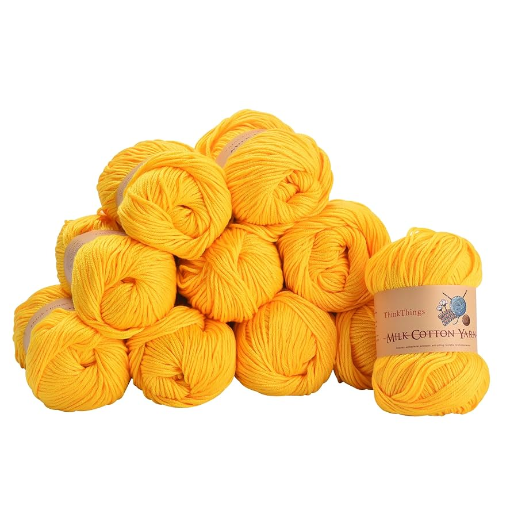
- Strength and Durability
Acrylic yarn is generally more wear-and-tear-resistant compared to cotton yarn. Cotton, being strong once wet, but overcomes repeated stress, induces fraying or breaking of it under tension.
- Moisture Absorption
Due to its moisture-wicking nature, cotton yarn is breathable enough and desirable for projects that demand natural fabrics and comfort; acrylic is not very absorbent. It traps heat with moisture and hence cannot be a suitable fabric choice in warm-climate situations.
- Maintenance
What comes to washing, cotton yarn is a more blemished hand in drying as it is liable to shrink, whereas acrylic yarn is easier to treat: it’s machine-washable and dries quickly. Hence, acrylic can be used for fabrics that need a little care.
- Texture and Feel
Cotton yarn seems to be very natural and soft, so it’s mainly used in garments and home texturing applications, whereas acrylic is somewhat artificial and hard in texture. Due to manufacturing innovations, however, it is now possible to produce acrylic yarns having softness quite close to that of natural fibers.
- Eco-Friendliness
Compare the Differences: Acrylic vs Cotton Yarn
|
Parameter |
Acrylic Yarn |
Cotton Yarn |
|---|---|---|
|
Source |
Synthetic, petroleum-based |
Natural, plant-based |
|
Softness |
Varies, can feel synthetic |
Naturally soft and smooth |
|
Durability |
High, resistant to wear |
Moderate, vulnerable to abrasion |
|
Moisture Absorption |
Low, retains less moisture |
High, highly absorbent |
|
Eco-Friendliness |
Less sustainable, non-biodegradable |
Biodegradable, more eco-friendly |
|
Care |
Easy, machine washable |
Requires gentler handling, easy to shrink |
|
Cost |
Generally cheaper |
More expensive, especially organic |
|
Color Retention |
Long-lasting, vibrant colors |
Colors fade over time |
|
Breathability |
Less breathable, traps heat |
Highly breathable |
|
Thermal Properties |
Warmer, insulation properties |
Cooler, suited for warm climates |
|
Weight |
Lightweight |
Heavier compared to acrylic |
|
Texture |
Can feel artificial |
Natural and pleasant to touch |
|
Hypoallergenic Comfort |
May cause irritation to some |
Gentler for sensitive skin |
|
Longevity |
Longer lifespan with proper care |
Shorter lifespan if not properly maintained |
Breathability and Comfort
Acrylic and cotton yarns are vastly different in terms of breathability and comfort, which are in turn based on their fiber constitution. Cotton yarn, as a natural fiber, is highly breathable and absorbs moisture exceptionally well, making it an ideal surface to produce for ecological clothing systems or frosty weather. I suppose it’s comforting, tingly, allowing the stifling heat to impressively escape upward.
Conversely, acrylic yarn does not allow the natural breathability that cotton does, but compensates by pressing heat retention to an advantage and thus keeping warm in its own terms-it performs best in cold weather. Then, in opposition to being an absorber, acrylic tends to repel water; this minimizes its chances of holding moisture, but at times becomes uncomfortable to wear. Peremptorily, the suitability of each yarn, so far as it pertains to the project demands and environmental considerations, will be assessed.
Common Uses of Acrylic and Cotton Yarn
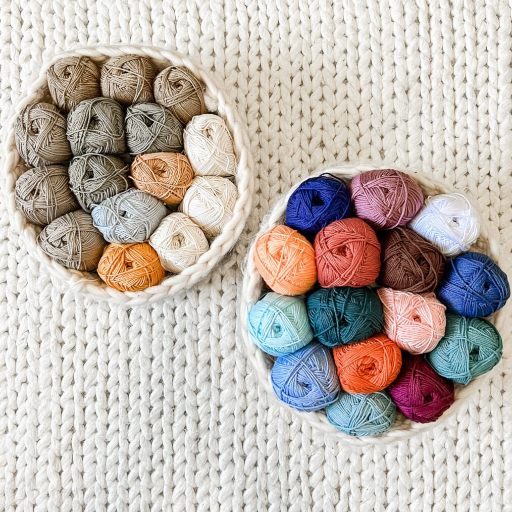
Acrylic yarn is suitable for all kinds of crafting projects. In greater need of everything, they’re commonly used in making blankets, sweaters, scarves, and hats that keep one warm. The water resistance makes them appropriate areas of use for items that are worn or exposed to the outdoor environment on a regular basis, and the acrylic yarn is a pretty easy yarn to care for.
Cotton yarn wins hands down in making dishes, summer tops, baby clothes, and home décor items that demand being lightweight and breathable. Its softness and absorbability combined with shape retention qualify it for use in those projects that demand a lot of comfort and structure. Depending on the characteristics that are required for the finished piece, both types of yarn are used for quite specific purposes.
Fashion and Clothing
Wool yarn with its warmth and stretch is much sought-after in the creation of winter clothes like sweaters, scarves, and gloves. This also includes high-end knitwear where wool yarn is chosen for its stitch retention that allows good stitch definition to produce texture and detail.
Conversely, cotton yarn is central to warm-weather fashion due to its light and breathable nature. It is used extensively for summer dresses, cardigans, and tops, with its natural fibers providing the comfort of moisture absorption. Recent uplifting data have been telling of an increasing focus on sustainable and eco-friendly materials; hence, organic cotton and recycled fiber find their way more in today’s designs. The trend marks a shift toward green practices in the apparel industry, with functional-style-smooth-sustainable clothing stepping into the present-day phase.
Home Decor Projects
Home decor is adopted aesthetically with function and sustainability. Going along with the current trends are natural materials like bamboo, reclaimed wood, and stone, which suggest an environmentally conscious design. Neutral tones paired with minimalist designs have gained popularity, creating calm and clutter-free spaces. Data indicate a huge demand for multifunctional furniture as a consequence of limited living space and the ways in which it is optimized. In contrast, energy-efficient illuminations, such as LED lights, with indoor flora, provide an ideal solution for ambiance improvement. The combination thus stands for what is termed modern home décor, whereby environmental consciousness meets fashionable living.
Outdoor Gear and Accessories
The outdoor gear business keeps morphing, with every evolution being ushered in by technology and consumer preferences. As an example, lightweight and highly resilient materials such as ripstop nylon and carbon fiber make for backpacks, tents, and trekking poles that provide better mobility and durability across terrains. Furthermore, portable solar panels and energy-efficient power banks are becoming some of the latest desires that an outdoor addicted generation aspires to maintain sustainable power solutions.
The waterproof and breathable apparel technologies, established by the likes of advanced membranes such as Gore-Tex, principally ensure protection against harsh weather conditions while simultaneously‘ maximizing comfort. With preferences toward modular designs and camping gear being increasingly compact, data indicates this as well, showing the urgent need for portability and adaptability to diverse terrains. These innovations, therefore, clarify the modern path toward functionality, durability, and environmental consciousness that the outdoor equipment sector now embodies, catering to the modern adventurer.
Environmental Impact of Acrylic and Cotton
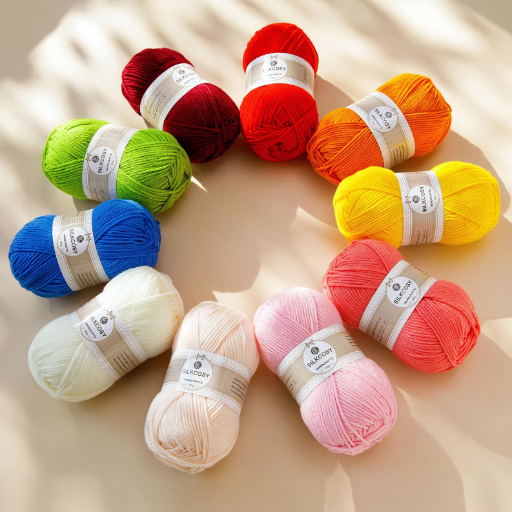
Comparing these two materials in terms of environmental impact, acrylic and cotton each present their own particular challenges. Acrylic is a synthetic fiber of fossil fuel origin, hence energy-intensive in production, which very heavily depends on non-renewable resources. Another damaging factor is that acrylic clothing adds to the issue of microplastics polluting the waterways and marine ecosystems for years on end as they are washed.
Said to be natural and biodegradable, cotton does have some environmental costs at the onset. Conventional farming of cotton utilizes huge quantities of water and pesticides, which later contribute to the degradation of soils and water resources. Nevertheless, organic farming of cotton presents itself as the best sustainable pathway by way of utilizing fewer chemicals and following environmentally friendly practices.
Environmental Concerns with Cotton Production
Growing concern for the environment promotes an examination of cotton production well beyond issues of water and pesticide usage. According to current reports, water used to produce merely one cotton T-shirt comes close to 2,700 liters, posing a strain on an already depleted global water resource pool. Secondly, synthetic fertilizers and chemical treatments used in cotton farming cause nitrogen oxides and methane emissions, which constitute a powerful source of climate change. Thirdly, cotton farming side effects need the conservation of biodiversity as pesticide applications adversely affect local flora and fauna, putting ecosystems at risk. Soil health is another area of concern, with intensive cotton farming often resulting in nutrient depletion, reduced fertility, and increased erosion. Transitioning to sustainable practices, such as crop rotation, integrated pest management, and organic certification, can mitigate these impacts and promote a more environmentally resilient cotton industry.
Biodegradability of Yarn Types
Depending on the composition of the material used and on environmental conditions, some will degrade faster; such is the case with biodegradability. Natural yarns include textiles made of wool, organic cotton, and hemp; practically all of these, under the right conditions, will biodegrade. For instance, wool may biodegrade in an average of one to five years in a soil environment, assuming there is moisture, oxygen, and microorganisms present. In a similar way, organic cotton does very well in breaking down; it usually decomposes completely in a matter of months when placed in the right composting environment.
On the other hand, various types of yarn that are synthetic pose a significant challenge to biodegradability. They have been constructed from petrochemicals and are made to be very durable, causing sometimes hundreds of years to pass before complete degradation. However, some types of so-called “biodegradable synthetic blends” will degrade only to a certain extent; the rest turns into microplastic pollution, which is now a menace to the ecosystem and serves as its contaminant.
Choosing the Right Yarn for Your Needs
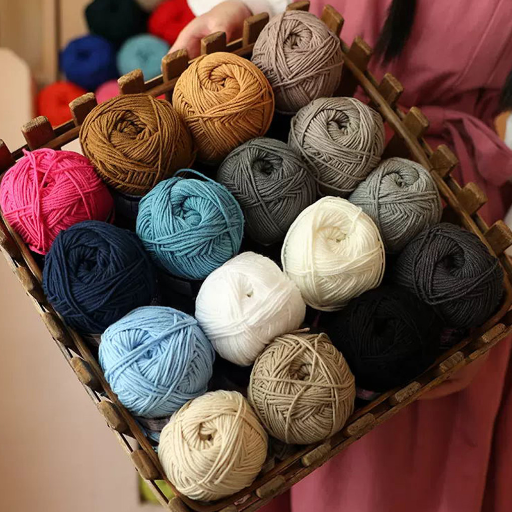
- Fiber Composition
The type of fiber—natural, synthetic, or blended—affects the texture, durability, and sustainability of your yarn choice. Natural fibers like cotton, wool, and silk are biodegradable and breathable, while synthetic fibers such as polyester and nylon offer enhanced durability, elasticity, and resistance to wear.
- Yarn Weight
Yarn weights directly affect the drape and structure of your finished project. Lighter weights are lace, fingering yarns, delicate and intricate designs; heavier weights are those that give structure and warmth, act bulky, super bulky for sweaters and blankets.
- Applications and End Use
Intended use is one of the factors that affect yarn attributes. Soft and flexible yarns provide greatest comfort for garments and wearables; sturdy yarns with high tensile strength are preferable for home décor or outdoor textiles.
- Environmental Impact
In light of sustainability issues, one must contemplate the environmental impact of any selected yarn. Projects mindful of nature will consider natural, ethically sourced, and recycled fibers or, alternatively, keep abreast of recent developments in biocompatible synthetics as another green option.
- Color and Dyeing Processes
Note that if they use a yarn-dyeing process to enhance its vibrancy, fade resistance, and ecological sustainability, it is likely that the dyeing process has a greater environmental impact. Naturally dyed yarns are environmentally friendlier than chemically dyed ones.
Comfort and Sensitivity Considerations
Yarn comfort may be critical for fitting very sensitive skin. Fibers like merino wool are excellent choices for softness and insulation and for being worn close to the skin. Bamboo and cotton yarns, in contrast, are excellent selections for the sensitive skin or allergic person, being breathable and hypoallergenic. New fiber technology has brought on blends and treatments that make everything softer while reducing irritability, giving more customizable choices for those with different needs. Another important consideration is how a yarn behaves after being worn for a prolonged time; some fibers end up getting eaten away or hard after wearing. On this very technical level, projects that look good thus far remain easy and comfortable enough to wear for an extended time.
Climate and Seasonal Use
The very choice of fiber and yarn should be dictated by climatic and seasonal conditions, affecting comfort, durability, and functionality. Wool and alpaca, for instance, absorb heat and insulate well and carry moisture away from the body so that they can be very suitable for use in cold regions. Conversely, cotton, bamboo, or linen are some of the lighter fibers and promote breathability and moisture absorption, thereby being better suited for warmer seasons. The modern synthetic fibers combine performance blends and hence allow use under different weather conditions by featuring temperature regulation and quick drying. Besides, data show that hybrid yarns based on natural and synthetic fibers provide a middle ground for insulation and breathability, with their respective concerns for transitional seasons. As such, seasonal optimization of fiber choice will keep projects functional and wearable throughout their use life and can cope with demands from a wide array of environments.
Reference Sources
1. An Experimental Study of Some Comfort-Related Properties of Cotton—Acrylic Knitted Fabrics: This study assessed the comfort characteristics of cotton, acrylic, and cotton-acrylic blend fabrics by examining their interaction with water, particularly focusing on wicking abilities, drying rates, and water vapor permeability.
2. Recent Advancements in Acrylic Fabric Applications: A Comprehensive Review and Future Trends: This comprehensive review highlighted advancements in functionalizing acrylic fibers to endow them with desirable properties like antimicrobial resistance, fire retardance, UV protection, and water repellency.
3. Effects of Acrylic Yarn on Thermal Comfort and Moisture Management Properties of Woven Shirting Fabrics: This study explored the impact of combining acrylic yarn with cotton, viscose, polyester (PES), and their blends in woven shirting fabrics on thermal and moisture management properties.
Frequently Asked Questions (FAQs)
Q: What are the pros and cons of using acrylic yarn for your crochet project?
A: Acrylic yarn is often favored for its affordability and wide range of colors, making it a popular choice for various crochet projects. However, it lacks the breathability that natural fibers like cotton provide, which can be a drawback in warmer climates. On the other hand, acrylic is durable and easy to care for, often machine washable, which is a significant pro for many crafters. When deciding on the right yarn for your crochet, consider the type of project you are undertaking; for example, amigurumi often works well with acrylic due to its structure. In summary, while using acrylic has its advantages, it’s essential to weigh these against the potential downsides.
Q: How does cotton vs acrylic compare for crochet and knit projects?
A: When comparing cotton and acrylic, it’s important to note the unique properties of each fiber. Cotton yarn, derived from the fibers of the cotton plant, tends to have a softer feel and greater breathability, making it suitable for summer garments. In contrast, acrylic yarn is a man-made fiber that offers elasticity and resilience, which can be ideal for projects that require durability. The decision between cotton or acrylic largely depends on the specific requirements of your crochet or knit project. If you’re working on a cotton project, you might prioritize the natural yarn’s softness, while for items that need to withstand wear, acrylic might be a better choice. Ultimately, both yarn options can produce beautiful results, but understanding their differences will help you select the right yarn for your crochet.
Q: What types of cotton yarn are best for crochet projects?
A: There are several different types of cotton yarn available, each suited for various crochet projects. For example, mercerized cotton yarn has a slight sheen and is often used for decorative items due to its ability to hold shape. Another option is cotton blends, which combine cotton with synthetic fibers for added durability and stretch. When selecting yarn for your crochet project, consider the texture and weight of the yarn; lighter weight cotton can work well for delicate items, while heavier varieties are suitable for more substantial projects. It’s essential to test out different types of cotton yarn to see how they perform in your next crochet project.
Q: Is acrylic or cotton yarn better for amigurumi?
A: When it comes to amigurumi, many crafters prefer using acrylic yarn due to its firmness and vibrant color options. Acrylic yarn projects often yield a more structured shape, which is crucial for the three-dimensional aspects of amigurumi designs. However, using cotton yarn can also be beneficial, especially for those looking for a more natural feel and drape. The choice between acrylic and cotton for amigurumi often comes down to personal preference and the desired final appearance of the finished piece. If you want a soft, squishy toy, cotton blends might be the way to go, while for a more durable and easy-care option, acrylic is usually preferred.
Q: What is the best yarn for your crochet project?
A: The best yarn for your crochet project hinges on several factors, including the type of project, desired texture, and care requirements. For projects like blankets or garments, wool and cotton blends can provide warmth and breathability, while acrylic yarn is often chosen for its affordability and wide range of colors. If you are creating an intricate design, consider the yarn fibers; finer yarns can help achieve detailed stitches. Additionally, think about the climate where the finished item will be used; natural yarn like cotton is preferable for warmer weather. In essence, the right yarn for your crochet should align with your project goals and personal crafting style.









